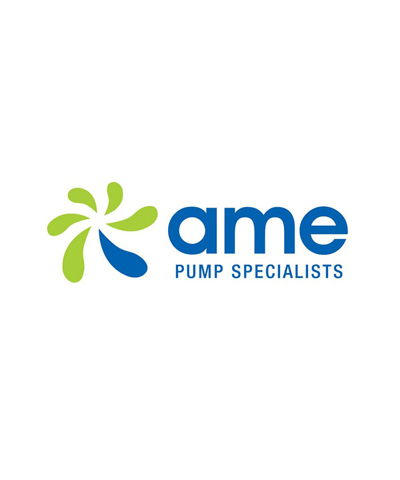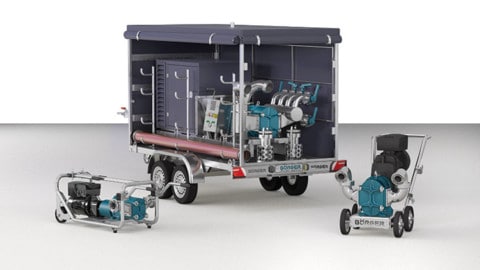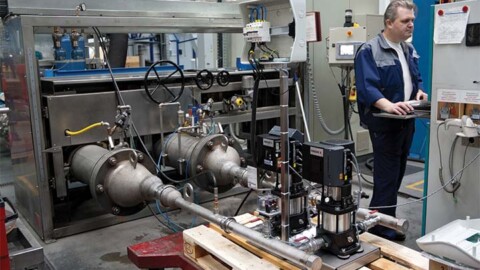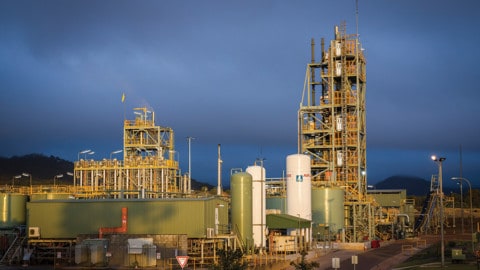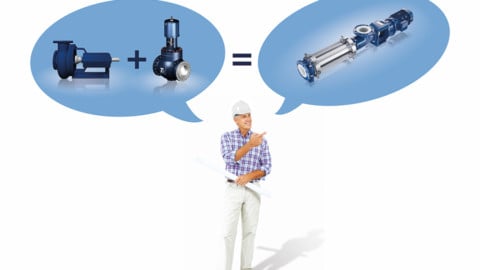The Australian institute of Refrigeration, Air-conditioning and Heating (AIRAH) has recently developed a draft guideline for the selection and application of centrifugal pumps used in the building services industry for pumping water and other fluids. This article extracts some of that guideline.
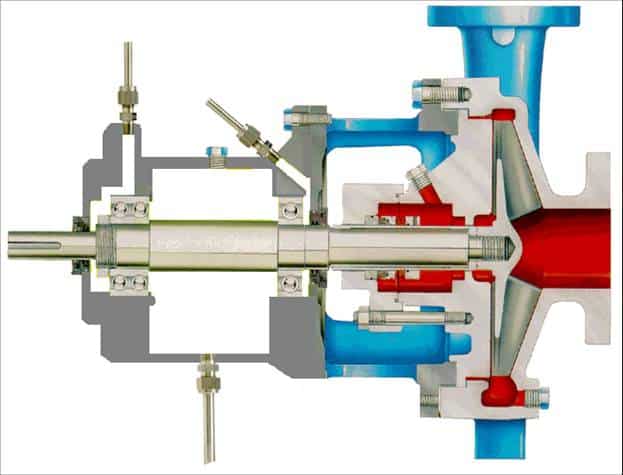
The systems approach
Centrifugal pumps perform many important functions in environmental control systems. A pump provides the energy to move water and other fluids through piping, fittings and equipment, and is the heart of many HVAC&R systems. Proper pump design considers not just the pump but the entire pumping system, including the supply and demand sides of the system, and how the individual system components interact.
Best-practice centrifugal pump application in the HVAC&R industry requires practitioners to take a “systems approach” to pump selection, control, installation and commissioning. In a systems approach, attention shifts away from individual components to focus on total system performance.
Selection information
Pumps are available in a range of volute and impeller combinations that meet the requirements of various pumping systems. Pump selection is the process of matching the characteristics of the pump to the requirements of the system.
A pump should be selected to operate within the stable portion of the pump curve. Information required by pump manufacturers to enable them to select an appropriate pump includes:
• Constant or variable flow design basis
• Maximum and minimum flow rate or flow profile
• System operating pressure (head) at maximum and minimum flow rate
• System operating temperature band, maximum and minimum temperatures
• Static pressure (head) at pump location at no flow condition
• Details of the fluid to be pumped including density, viscosity, etc
• Whether the system is open or closed-circuit
• Whether the fluid contains any solid matter, e.g. mud, particulate
• Materials of construction, system and pump
• The drive and, if electric, the power supply available
• Any starting limitations of the power supply
• Environmental conditions of the pump location, including ambient temperature and altitude
• Type of motor and enclosure, e.g. open protected, totally enclosed, etc
• Preferred speed limitation (governed by best efficiency)
• Type of vibration isolation required (inertia base, rubber in shear, seismic or standard springs)
• Any special electric controls, e.g. integral VFD, thermistors in windings, thermal overload protection, etc
Best practice pump application
• Document system operating conditions and system performance or outcome requirements
• Develop designs and design options that achieve the performance requirements or optimise the system outcomes
• Assess alternative designs and options, and select and document the option that provides the most benefit for the least cost
• Implement the selected option in accordance with the design documentation
• Assess installed system energy consumption and relate it to system performance
• Monitor and fine-tune the system over time
• Operate and maintain the system for optimum performance
• In particular, the pump selection, the pump connections to the distribution system and the method of pump control can have a significant impact on the system performance outcomes.
Centrifugal pump costs
When selecting centrifugal pumps, considerations should include life-cycle costs such as:
• First costs (purchase and installation)
• Ongoing costs
• Energy use
• Maintenance requirements
• Reliability requirements.
The power consumed by a pump is dependent on the operating duty and the motor selected, including the power needed for any drive and impeller losses.
System design and specification
Centrifugal pumps cannot be designed in isolation from the distribution system. Designers and centrifugal pump suppliers need to take a holistic “systems” approach to design.
System resistance calculations
For a fixed piping network there will be a specific relationship between the flow through the network, and the pressure (head) required to produce the flow, independent of the pump used. The first step in the design of any pumped system should be the construction of this pressure-capacity curve for the system, called the system curve. Accurate system resistance calculations are necessary if the centrifugal pump is to perform in accordance with the required system design.
It is recommended that calculation of the system resistance be carried out by estimating changes in total pressure throughout the system.
Effects of errors in estimating system resistance
An error in the system curve calculation may result in the selection of a pump that is sub-optimal for the system. For detailed information on calculating piping and fitting system resistance, refer to AIRAH DA16 Water piping for air conditioning.
Safety factors
System designers sometimes apply “safety factors” to their estimate of the system resistance, to safeguard against inaccurate evaluation. On occasion, these safety factors may compensate for resistance losses that were overlooked, or for variations occurring during the installation process, and the actual system will deliver design flow. The usual result, however, is that the estimated system resistance, including the safety factors, is in excess of actual system resistance. Since the centrifugal pump was selected to design conditions, it will deliver more fluid because the actual system resistance at the design flow rate is less than design estimate.
This means the centrifugal pump will usually be operating at a less efficient point on the pump performance curve, and may require more power than would have been the case at design flow. It may also result in much higher noise levels. Under these conditions, it may be necessary to reduce the centrifugal pump speed or to increase the actual system resistance (e.g. adjust a valve) to the value determined in the design calculations.
Adding safety factors to an accurately designed and calculated system curve will generally result in an oversized pump. Adding subsequent safety margins to installed pumps and to the pump motors compounds the problem of oversizing. Safety factors applied by designers to allow for uncertainties should be documented within the system design documentation and these are the only factors or margins that should be applied to the pump.
It is essential that, when a safety factor is applied during the system design calculations, it is quantified and documented and the information made available to other stakeholders in the project. Designers in HVAC&R often use a safety factor in the order of 10 per cent.
Centrifugal pump surge
Surges or transient pressures occur in pumping systems when pumps start and stop, or when valves open and close quickly. Pressure surges can stress system pipes, valves and fittings – high pressure surges cause bursts, and low pressure surges cause collapses. Pressure surges can also cause water hammer, a loud and potentially destructive internal force that can generate significant vibration.
Electronic starting and stopping of the pump motor is an effective part of the solution to system surge problems. An advantage of VFDs is the soft-starting characteristics of the associated electronics. Slow-acting valves are also a design solution that should be considered.
System hunting
The term “hunting” applies to an under-damped control circuit. Sensors can be used to control valves or motor speeds, but if the control system responds too quickly, it will overcorrect and have to readjust in the other direction. Hunting refers to the condition where the system is continually moving back and forth without finding a stable control point.
System stability
System stability refers to the ability of the system to return to its normal operating condition after it has been temporarily displaced from that condition. Some centrifugal pumps are not stable at all operating ranges, and the centrifugal pump will continue to operate at the displaced condition even though the cause of the displacement has been removed. This is sometimes referred to as bi-stable flow, where the centrifugal pump can operate at two distinctly different conditions in the same system.
Optimising system designs
Systems can be optimised for a variety of goals, including energy efficiency, life-cycle costs, reliability and redundancy. When energy optimisation is a key goal, the following should be considered:
• Reducing flows and fluid velocity will reduce pumping energy
• Reducing system resistance – maximise pipe sizes, and minimise bends and fittings to minimise friction losses. Include a straight run into and out of the pump, or if that is not possible, use turning vanes and swirl diffusers to straighten flow.
• Accurate and confident design calculations remove the need for excessive safety factors and margins
• Commissioning for energy efficiency outcomes – measure, set and monitor KPIs
• Controlling for energy efficiency outcomes – for variable flow systems, use variable speed control and no throttling valves or bypass lines
• Maintenance and management – consider system maintenance, filters and strainers, and automatic and remote monitoring systems.
Energy is frequently wasted in pumping systems, and this wastage can be significant. A pumping system capable of optimising operating energy use will have the following properties:
• It is a variable-flow system with a pump that varies its speed to match the operating load conditions
• Design flow rates are minimised by maximising system temperature differentials
• Pipes are sized as large as possible for the design flow to minimise resistance, allowing for practical installation considerations and realistic capital costs
• The system incorporates some means of automatically controlling differential pressures and flow rates, across all terminal unit branches
• Pump speed is controlled to maintain a constant pressure across the most remote pressure-controlled sub-branches of the piping system
• Pressure losses through pipe fittings is minimised by avoiding non-essential bends and fittings, and by using wide-swept bends wherever possible.
This article is an edited version of an article that was originally published in HVAC&R Nation magazine, and was reproduced with AIRAH’s permission. The information was adapted from AIRAH’s DA01 Centrifugal Pumps manual.




